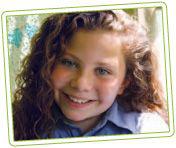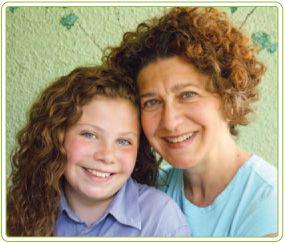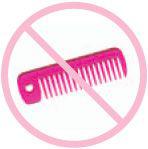B003YL4KS0 EBOK (30 page)
Authors: Lorraine Massey,Michele Bender

8
Gel isn’t a must for kids’ hair. Their hair is naturally healthier and more hydrated than adults’ hair. But if your child has a high frizz factor, or for special occasions, you can apply a small amount of gel that is free of silicone, alcohol, and parabens to the canopy of the hair in a downward motion.
STICKY SITUATIONSWhat happens when your curly kid gets glue, paste, food, or a wad of gum in his hair? Rub the area with an ice cube until the stickiness hardens and begins to crumble. Then make a paste out of a few drops of vinegar and about ¼ teaspoon of conditioner, and apply it to the matted spot. Let it soak in. Gently work the mess out with your fingers or with the end of a knitting needle.
Kids’ curls don’t need a daily cleansing. Lavender spray is great in the morning when your kids wake up with ruffled hair and you don’t want to cleanse or fully wet their hair. Or you can just spritz their hair with a detangling spray made by combining equal amounts of water and conditioner in a spray bottle. I also use lavender spray to deodorize and reorganize my kids’ curls after a day at the beach. (A little-known side benefit for school-age kids is that lavender is a good deterrent against lice.)
If your curly haired daughter insists on wearing her hair straight, comb it with your fingers and put it in a ponytail to dry. Or braid the hair while it’s still wet, which will help eliminate frizz, but do not pull too tightly.
When it comes to cutting your child’s curly hair, it’s best to follow its intrinsic shape, whether it’s waves, ringlets, or smaller curls, and let your child wear a freer, natural look. And remember to cut it only when it’s dry. This works well for both girls and boys, although older boys are apt to resist a head of ringlets no matter how charming it looks to you.
To find someone who can cut your child’s curls, follow the same advice I give to adults (see
chapter 9
,
page 91
) because not every hairdresser can cut curls. To trim your child’s hair yourself, follow the tips in
chapter 10
(see
page 99
). The trimming techniques are helpful if you just want to clean up their knotty, frayed ends or trim their bangs, which tend to need a cut sooner than the rest of their hair.
“When I was young, people used to ask me if my curls were a permanent. I would say, ‘Yes, they are permanent—for life.’”
—L
ORRAINE
When my three kids were babies and I’d notice a dry patch on their scalps, I’d massage it gently with olive oil. After that, none of them had cradle cap (a yellowish crust that often develops on infant scalps), and their hair and scalps looked healthy and smelled clean. If your child does get cradle cap, both jojoba oil and olive oil are great for curing it. Gently rub the oil in the spot and leave it on overnight. In the morning, cleanse your child’s hair with conditioner. (Extra virgin olive oil is also a great treatment for diaper rash!)

I remember meeting a four-year-old girl whose father told me, “She hates her curls, so we try to point out women who have beautiful curly hair.” The child had a head of gorgeous ringlets, but when I complimented her on them, she frowned and hid her head in her father’s coat. It can be a casual remark made in the child’s company, or perhaps someone making too much of a small child’s hair, but children are quick to pick up on prejudices of all kinds. Still, you can help them through it. Once in a while, point out a woman or man with beautiful curly hair. Or talk about how much you like your own curls. But don’t make a big deal out of it or they’ll figure something’s up.
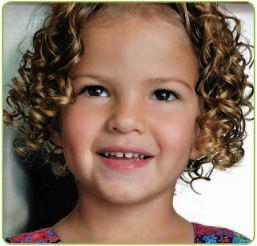
If you have naturally straight hair and your child has curly hair, find her a curly-haired mentor—someone she can bond with over her hair, its glory, its problems, and its orneriness. Many of us curly girls might have been spared years of agony, especially during adolescence, if only we’d had a curly-girl mentor to talk to. I’d spend hours in front of the mirror sobbing because I thought I looked hideous. When it was really humid, I’d run home during lunchtime and put on my brother’s balaclava, a skin-tight woolen cap.
That’s why I try to be a mentor to any curly haired child or teenager who needs it. I think my teenage years would have been very different if only an enlightened curly girl had taken me under her wing and said, “Call me if you have any questions about how to take care of your curls.”
If you are a curly girl who is still in denial of your curls and you have a curly kid, it’s time to start loving your own curls. Whether you like it or not, you are your child’s first beauty consultant. If you love your curls, your child will love hers. But if you hide them—even if you never actually talk about not liking your curls, or you straighten your hair—you’ll send a message that curls are something to hide and be ashamed of. So many of my curly clients recall mothers who did this, making them believe that straight hair was beautiful and curly hair was ugly.
CURL CONFESSIONAsa Schiller
entrepreneurBeing a curly girl married to a curly guy, I knew exactly how to handle my daughter Clara’s curly hair. I’ve never straightened it or used a brush or shampoo, and I do a big conditioning once a week while she sits in the bath. This is very different from how my mother handled my curly hair. She’d brush it out, which hurt and made it look like a giant fuzz ball, and sigh, “I just can’t do anything with this hair,” which I interpreted as “your curls are ugly.”
As an adult, I learned to just let my curls be. It’s okay if a curl is sticking out on one side and if everything is not perfectly even. Once I realized this I felt such a huge sense of relief! I finally loved my curls and I wanted to pass this on to Clara from a young age. I wanted her to feel that having curly hair was something unique and for her to feel good about her hair. People always compliment her curls (one woman said her hair made her look like a fairytale princess) and often say they love it. But they’re not the only ones. Clara loves her hair. She sees it as special and beautiful. And if that doesn’t warm a curly mom’s heart, I don’t know what does!
DO’S AND DON’TS
How to Gently Remove the Knots•
DO
saturate the knot and surrounding area with conditioner.•
DO
isolate the knot with one hand and hold it in between your thumb and forefinger. With the other hand, gently pry each strand of hair from the knot.•
DO
be gentle. Think of these knots as the equivalent of releasing a piece of jewelry that’s gotten caught in your favorite sweater. You wouldn’t tug and rip, you’d be ever so gentle when removing it.•
DON’T
use a brush or a comb, which will shred and pull hair and fuse the open cuticles that then attach to each other like Velcro.
•
DON’T
attempt to remove knots without conditioner or you will break and rip the hair, which will cause more knotting in the near future.
Other women talk about not feeling accepted by their mothers because of their mothers’ disdain of their curls. Comments like, “Oh, so that’s how you wear your hair these days” or “Do something with your hair; it looks awful” hurt them so deeply that memories of these remarks still sting even though some of these women are in their fifties!
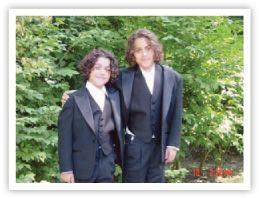
Shelley Ozkan’s (
page 31
) boys take after their mom and wear their curls with pride.
